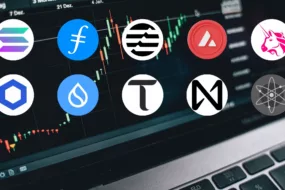
Bitcoin Layer 2: Key Projects Driving Speed and Scalability
Bitcoin Layer 2 refers to secondary protocols developed on top of the Bitcoin blockchain to enhance scalability and transaction speed. These solutions enable faster, cost-effective transactions by processing them off-chain while maintaining the security of the main blockchain. Layer 2 solutions aim to improve user experience by alleviating congestion on the Bitcoin network and facilitating broader adoption of Bitcoin for everyday transactions.
Key Takeaways
- The role of Layer 2 solutions in Bitcoin’s scalability.
- A study of popular bitcoin layer 2 projects
- Future trends in blockchain interoperability.
Top Bitcoin Layer 2 Projects
1. Lightning Network

Designed in 2016 by Joseph Poon and Thaddeus Dryja, the Lightning Network uses off-chain channels to accelerate Bitcoin transactions and reduce fees compared to the main blockchain.
The Lightning Network lets users establish a payment channel between two parties. This ensures multiple transactions on off-chain, with final settlement on the main blockchain at channel closure.
2. Stacks

Stacks uses a consensus method known as Proof of Transfer (PoX) to link its transactions to Bitcoin. It further inherits Bitcoin’s strong security for all network activities.
Stacks brings smart contracts to Bitcoin without altering its original protocol. It achieves this through Clarity, a programming language known for its secure and predictable nature, which helps limit bugs and exploits.
Stacks further extends its functionality to support DeFi, NFTs, and other blockchain applications.
3. Satoshi VM

Satoshi VM is a decentralised Bitcoin ZK Rollup Layer 2 solution. Its architecture includes a Sequencing Layer that works similarly to Ethereum’s Execution Layer in Rollups. The Satoshi VM architecture groups multiple transactions into a batch that is verified as one by a Rollup Node. It also uses Taproot scripts for on-chain validation, ensuring transactions are checked without altering Bitcoin’s core rules. Additionally, data availability mechanisms ensure transaction data is accessible for verification.
4. Merlin Chain

As an EVM-compatible chain, Merlin Chain offers low fees and better scalability. The addition of ZK-roll-up technology improves Merlin’s performance. Moreover, it supports popular Bitcoin protocols such as BRC20, Bitmap, and BRC420, allowing more users to connect and transact.
Merlin Chain’s architecture integrates decentralised Oracle networks and on-chain fraud-proof systems. Its Sequencer nodes oversee data transmission. The MERL token is key in staking, fee transactions, and liquidity provision.
5. Rootstock Infrastructure Framework

The Rootstock Infrastructure Framework (RIF) is a set of open-source protocols to extend Bitcoin’s capabilities by enabling decentralised applications (dApps). It uses merged mining to allow miners to mine Bitcoin and Rootstock simultaneously with no extra resource costs.
RIF provides multiple tools that make creating decentralised finance (DeFi) applications easier. Its offerings include identity management, payment solutions, data feeds (oracles), and decentralised storage.
Moreover, its two-way peg system, PowPeg, enables secure, efficient transfers between Bitcoin and Rootstock Bitcoin.
6. Liquid Network

Blockstream creates this network as a sidechain to operate alongside the Bitcoin blockchain while remaining compatible. The Liquid Network uses a federated approach, accelerating transaction times and enhancing user privacy by implementing Confidential Transactions technology. This technology hides transaction amounts, thereby adding an extra level of privacy for users.
Beyond accelerating transaction speeds, the Liquid Network also enables the creation and trading of digital assets like stablecoins and security tokens. A federation of exchanges and financial institutions governs the network.
7. Dovi
Dovi is a smart contract platform compatible with the EVM. This allows developers to deploy Ethereum-based smart contracts on the Bitcoin network, expanding the possibilities for dApps.
A standout feature of Dovi is its use of Schnorr signatures that allows decentralised multi-signature transactions. Furthermore, Dovi accommodates multiple asset types, such as BRC20 and ARC20 tokens, for secure chain transfers.
8. CKB Public Chain

The CKB Public Chain, known as Nervos CKB (Common Knowledge Base), is a public and permissionless layer-1 blockchain that optimises performance on standard hardware and network bandwidth. It uses a Proof of Work consensus mechanism, similar to Bitcoin, but enhances the Nakamoto consensus for better efficiency. The CKB-VM, a virtual machine compatible with the RISC-V instruction set, supports scripting in any programming language.
A key feature of the CKB Public Chain is its emphasis on verification instead of computation. It also supports the Universal Verification Layer, which promotes the creation of scalable and interoperable blockchain protocols, aiding in developing a self-evolving distributed economy.
ALSO READ: Ethereum vs Bitcoin: Which will perform in the longterm
Bitcoin’s Limitations and the Rise of Layer 2 Solutions
Bitcoin, despite its groundbreaking role as the first cryptocurrency, faces inherent limitations that hinder its widespread adoption for everyday transactions. These challenges primarily revolve around:
- Scalability: Bitcoin’s blockchain can only process a limited number of transactions per second, leading to network congestion and high transaction fees during peak usage.
- Transaction Speed: Confirming transactions on the Bitcoin blockchain can be slow, taking several minutes or even hours in some cases. This delay makes it impractical for time-sensitive applications.
- High Transaction Fees: When the network is congested, transaction fees can increase significantly, making small or frequent transactions uneconomical.
These limitations have spurred the development of Layer 2 solutions, which aim to overcome these challenges without compromising Bitcoin’s core security and decentralization principles.
How Bitcoin Layer 2s Work
Here’s a step-by-step breakdown of how they work:
- Layer 2 solutions, like the Lightning Network, take transactions off the main Bitcoin blockchain (Layer 1). Users create a “payment channel” between them, allowing them to send and receive Bitcoin without every transaction needing to be noted on the blockchain.
- To start, two users lock up a certain amount of Bitcoin in a smart contract on the Bitcoin blockchain. This creates a payment channel where they can transact back and forth instantly without waiting for network confirmations.
- Users can exchange Bitcoin as many times as they like in this channel. Each transaction updates the balance of Bitcoin each user would receive if the channel were closed, without involving the blockchain.
- When users want to finalize the transactions, they close the payment channel. The final balance is then noted on the Bitcoin blockchain, and each user receives their respective Bitcoin amounts.
- These Layer 2 transactions reduce the load on the main Bitcoin network, leading to lower fees, faster transactions, and greater scalability.
Comparing Bitcoin Layer 2 to Other Blockchain Scaling Solutions
To fully appreciate the potential of Bitcoin Layer 2 solutions, it’s essential to understand how they compare to scaling solutions on other blockchains.
This comparison provides valuable context by highlighting the unique advantages and limitations of each approach.
| Feature | Bitcoin Layer 2 | Ethereum Layer 2 | Other Layer 2 Solutions (Polygon, Arbitrum etc.) |
|---|---|---|---|
| Primary Focus | Scaling transaction throughput, enabling micropayments, and expanding Bitcoin’s functionality (smart contracts, dApps). | Improving scalability and reducing transaction costs for Ethereum’s existing dApp ecosystem. | Enhancing scalability and interoperability for various blockchains, often with a focus on specific use cases. |
| Underlying Security | Inherits the robust security of the Bitcoin blockchain (Proof-of-Work). | Relies on the security of the Ethereum blockchain (Proof-of-Stake). | Security varies depending on the specific blockchain and Layer 2 implementation. |
| Technology | Primarily uses payment channels (Lightning Network), sidechains (Liquid Network), and smart contract platforms (Stacks). | Employs various technologies like Optimistic Rollups, zk-Rollups, and state channels. | Diverse range of technologies, including sidechains, Plasma, and Validium. |
| Transaction Speed | Significantly faster than on-chain Bitcoin transactions, often near-instantaneous. | Significantly faster than on-chain Ethereum transactions, with varying speeds depending on the specific solution. | Transaction speeds vary depending on the specific solution and blockchain. |
| Transaction Fees | Generally much lower than on-chain Bitcoin transactions. | Significantly lower than Ethereum’s “gas fees.” | Fees vary depending on the solution and network usage. |
| Decentralization | Can vary depending on the specific solution; Lightning Network is highly decentralized, while sidechains may have trade-offs. | Decentralization varies depending on the specific solution and its implementation. | Decentralization levels differ based on the solution and underlying blockchain. |
| Smart Contract Capabilities | Limited but growing, with platforms like Stacks enabling smart contracts on Bitcoin. | Strong smart contract capabilities inherited from Ethereum. | Smart contract support depends on the specific solution and blockchain. |
| Interoperability | Efforts are underway to improve interoperability between different Bitcoin Layer 2 solutions and with other blockchains. | Focus on interoperability within the Ethereum ecosystem and with other EVM-compatible chains. | Many solutions prioritize interoperability with other blockchains and Layer 2 networks. |
Challenges of Bitcoin Layer 2
Bitcoin Layer 2 is not without challenges. Here are some.
1. Security Risks
Operating off-chain, Bitcoin Layer 2 systems are more exposed to security risks, like channel exhaustion and network attacks. For example, a bad actor could flood the network with micro-transactions, clogging the system and potentially disrupting service. This vulnerability requires you to take additional precautions, which can complicate usage and increase costs.
2. Network Coordination
Bitcoin Layer 2 channels require continuous node coordination for a smooth transaction process. This dependency means that payments could get stuck if a node goes offline or fails to relay a transaction.
3. Transaction Costs
Though bitcoin layer 2 aims to reduce transaction fees, the cost of opening and closing channels on the main Bitcoin blockchain remains. These costs can add up, particularly if you frequently open or close channels.
4. Liquidity Requirements
Bitcoin Layer 2 solutions like the Lightning Network rely on sufficient liquidity to facilitate transactions. Transactions may get delayed or denied when channels lack enough Bitcoin to support large or frequent payments.
5. Scalability Constraints
While bitcoin layer 2 solutions aim to enhance Bitcoin’s scalability, they often face limitations in effectively processing large volumes of transactions. For instance, the Lightning Network can handle only a few payments per channel.
The Future of Bitcoin Level 2
The future of Bitcoin Layer 2 solutions is brimming with potential, with ongoing innovations and exciting developments on the horizon. Here are some key trends to watch:
1. Increased Adoption of the Lightning Network
- We can expect to see wider adoption of the Lightning Network, with more wallets, exchanges, and payment processors integrating it. This will lead to faster and cheaper Bitcoin transactions, making it more practical for everyday use.
- We may also see the emergence of new applications built on Lightning, such as decentralized exchanges, micropayment platforms, and instant cross-border payment solutions.
2. Rise of Advanced Layer 2 Technologies
- Technologies like Liquid Network and RGB are likely to gain more traction, offering enhanced privacy, security, and smart contract capabilities for Bitcoin.
- We might also see the development of new Layer 2 solutions based on technologies like ZK-rollups and optimistic rollups, which offer further scalability and efficiency improvements.
3. Interoperability and Cross-Chain Solutions
- There’s a growing focus on interoperability between different Layer 2 solutions and even between Bitcoin and other blockchains. This will enable seamless transfer of assets and data across different networks, unlocking new possibilities for decentralized finance (DeFi) and other applications.
4. Enhanced Security and Privacy
- Future Layer 2 solutions will likely prioritize security and privacy, with advancements in cryptography and zero-knowledge proofs. This will help to mitigate risks associated with hacks and exploits while protecting user privacy.
5. Growing Developer Ecosystem
- As Layer 2 technologies mature, we can expect a surge in developer activity and innovation. This will lead to the creation of new and exciting applications and services built on Bitcoin, further expanding its utility and reach.
Upcoming Projects and Developments
- Taro: A protocol being developed by Lightning Labs that will enable the issuance of assets on the Lightning Network, potentially leading to the creation of stablecoins and other tokens on Bitcoin’s Layer 2.
- Drivechain: A proposed soft fork that would allow for sidechains to be securely pegged to the Bitcoin blockchain, enabling greater experimentation and innovation with Layer 2 solutions.
- Stacks 2.0: A platform that brings smart contracts and decentralized applications to Bitcoin, leveraging its security while enabling new functionalities.
The future of Bitcoin Layer 2 solutions is dynamic and full of possibilities. These advancements will not only address Bitcoin’s scalability challenges but also unlock new use cases and drive further adoption of the leading cryptocurrency.
Layer 3: Expanding the Horizons of Blockchain Technology
Layer 3 solutions represent an evolution beyond the scaling focus of Layer 2. They aim to enhance interoperability and application-specific functionality. Imagine specialized blockchains optimized for particular use cases, like gaming or supply chain management.
Layer 3 can enable:
- Cross-chain communication: Seamlessly connect different Layer 2 solutions or even separate blockchains.
- Customizable functionality: Develop tailored solutions for specific needs, optimizing performance and efficiency.
- Advanced applications: Support complex decentralized applications with unique requirements.
This layer fosters innovation and expands the possibilities of blockchain technology by creating a more interconnected and versatile ecosystem.
Impact on Market Dynamics: Bitcoin Layer 2 and the Future of Crypto
Bitcoin Layer 2 solutions have the potential to significantly reshape cryptocurrency market dynamics. By increasing transaction speed and lowering costs, these solutions could lead to a surge in trading volumes as users engage more actively with Bitcoin. This increased activity could, in turn, reduce price volatility by facilitating smoother and more efficient market operations.
Furthermore, as Bitcoin becomes more user-friendly and accessible for everyday transactions, we can expect to see a shift in user behavior. Micropayments and casual spending with Bitcoin could become commonplace, driving wider adoption and integrating it further into the global economy.
The enhanced scalability and functionality offered by Layer 2 solutions could also attract institutional investors who have previously been hesitant due to Bitcoin’s limitations. This influx of institutional capital could further stabilize the market and contribute to Bitcoin’s long-term growth.
Moreover, by addressing scalability concerns and demonstrating its potential as a practical medium of exchange, Layer 2 solutions could strengthen Bitcoin’s position as a potential reserve currency. Increased confidence in its ability to handle large-scale transactions and serve as a reliable store of value could encourage governments and institutions to consider Bitcoin as a strategic reserve asset.
How Bitcoin Layer 2 impacts Bitcoin Adoption
Bitcoin Layer 2 solutions are poised to significantly boost Bitcoin’s adoption among everyday users and businesses. By making transactions faster, cheaper, and more scalable, these solutions address key barriers to mainstream use. Imagine paying for your coffee with Bitcoin in seconds, without hefty fees.
This enhanced usability can attract new users and businesses, driving wider acceptance. Moreover, Layer 2 technologies can unlock innovative applications like micropayments and decentralized finance (DeFi) on Bitcoin, further expanding its utility and appeal. As these solutions mature, they pave the way for Bitcoin to become a truly global currency for everyday transactions and beyond.
Conclusion
Bitcoin Layer 2 solutions enhance the functionality and efficiency of the Bitcoin network by enabling faster and more cost-effective transactions while maintaining security. These advancements are crucial for Bitcoin’s scalability and everyday use, making it a more potent investment choice with every passing day.
If you’re looking to trade or invest in Bitcoin, Mudrex is the easiest option available. With a simple interface and access to over 600 other coins, you can diversify your portfolio to your liking. Download the Mudrex app today to start trading Bitcoin and explore a wide range of investment opportunities.
Frequently Asked Questions
1. What is Bitcoin Layer 2?
Bitcoin Layer 2 refers to secondary protocols built on the Bitcoin blockchain to enhance scalability and transaction speed.
2. How does the Lightning Network work?
The Lightning Network allows users to develop payment channels for off-chain transactions, reducing fees and increasing transaction speed.
3. What are the advantages of using Layer 2 solutions?
Layer 2 solutions provide faster transactions, lower fees, and better scalability while maintaining the security of the main Bitcoin blockchain.
4. What challenges does Bitcoin Layer 2 face?
Bitcoin Layer 2 encounters security risks, network coordination, transaction costs, liquidity requirements, and scalability constraints.
5. How do Layer 2 solutions differ from Ethereum Layer 2?
Bitcoin Layer 2 focuses on scaling Bitcoin for transactions and smart contracts, while Ethereum Layer 2 aims to enhance dApps and reduce gas fees.




